
Agapanthus africanus, or the African lily, is a flowering plant from the genus Agapanthus found only on rocky sandstone slopes of the winter rainfall fynbos from the Cape Peninsula to Swellendam. It is also known as the lily-of-the-Nile in spite of only occurring in South Africa.

Freesia is a genus of herbaceous perennial flowering plants in the family Iridaceae, first described as a genus in 1866 by Christian Friedrich Ecklon (1886) and named after the German botanist and medical practitioner, Friedrich Freese (1795-1876). It is native to the eastern side of southern Africa, from Kenya south to South Africa, most species being found in Cape Provinces. Species of the former genus Anomatheca are now included in Freesia. The plants commonly known as "freesias", with fragrant funnel-shaped flowers, are cultivated hybrids of a number of Freesia species. Some other species are also grown as ornamental plants.

Centranthus ruber, the red valerian, spur valerian, kiss-me-quick, fox's brush, devil's beard or Jupiter's beard, is a popular garden plant grown for its ornamental flowers.

Protea laurifolia, also known as the grey-leaf sugarbush, is a shrub from South Africa. It is native to the Cape Provinces of South Africa.
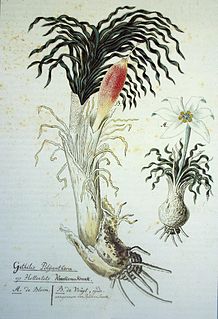
Gethyllis, commonly called Kukumakranka, Koekemakranka, or Kroekemakrank, is a genus of bulbous plant in the Amaryllid family with some 33 accepted species.. It is native to the Cape Provinces, the Northern Provinces and the Free State of South Africa, as well as Botswana and Namibia.
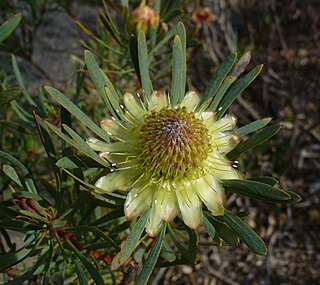
Protea scolymocephala, also known as the thistle protea or thistle sugarbush, is a flowering plant from the genus Protea native to South Africa.

Astroloba rubriflora is a succulent plant found in the mountainous Karoo area around Robertson, South Africa. It is listed as a Vulnerable species on the IUCN global Red List.
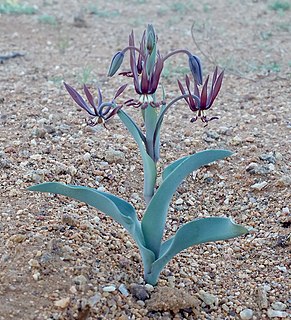
Ornithoglossum is a genus of plants native to southern Africa, some of which are widely cultivated as ornamentals. Nine species are currently recognized, as of April 2014:

Commiphora caudata, the hill mango or green commiphora, is the most abundant Asian species of Commiphora of flowering plants in the frankincense and myrrh family, Burseraceae. It can be found in Southern India and Sri Lanka, usually growing in the full sun on hilly granite rock outcrops in dry zone areas. It is a small to medium-sized deciduous tree which is said to be able to reach height of 10-20m, but usually is less high. The tree has a smooth, succulent green bark, which partly flakes off with age, giving rise to a characteristic patchwork of green and brown patches. Its sap has a strong resinous scent. The tree has medicinal properties. The fruit is a globose fleshy drupe with 2 to 6 valves and 1 seed that is black and has 4 wings. Remnants of branches can form a kind of thorns on the trunk. The flowers have a greenish to cream-yellow pedestal with pink to red petals.

Daubenya zeyheri (Kunth) J.C.Manning & A.M.van der Merwe is one of 8 bulbous species in the genus, all endemic to the winter rainfall Strandveld of South Africa, and mostly growing on doleritic clays along the West Coast, Western Cape. It is closely related to Daubenya marginata J.C.Manning & A.M.van der Merwe. At first believed to consist of a single species, Daubenya aurea, the genus was expanded in 2000 to include the genera Androsiphon and Amphisiphon and various species that had previously been classified as Polyxena, Massonia, or Neobakeria. "The poor congruence between morphological and other characters within Hyacinthaceae has also made generic circumscriptions very difficult. One of the consequences of this has been the recognition of a large number of genera that are poorly defined morphologically." - All 8 species have two spreading, prostrate leaves and tubular flowers that range from white to yellow or red, and in 6 of the species are followed by smooth glossy seeds within papery capsules that lend themselves to anemochory or wind dispersal. The inflorescence is produced at ground level on a sub-surface peduncle between the two leaves. Species are variously pollinated by bees, butterflies, moths, the monkey beetle Lepisia glenlyonensis and sunbirds. The water-retaining nature of doleritic clays ensures their remaining moist for longer than clays formed from shales of the Karoo series. Exceptionally D. namaquensis is found in deep red sands and D. zeyheri in calcareous coastal sands.
Graham Dugald Duncan(born 1959) is a South African botanist and specialist bulb horticulturalist at the Kirstenbosch National Botanical Garden, Cape Town, South Africa.
Protea vogtsiae, also known as the Kouga sugarbush, is a small flowering shrub of the genus Protea within the family Proteaceae, which is only found growing in the wild in the southern Cape Region of South Africa.

Protea angustata, also known as the Kleinmond sugarbush, is a flowering shrub that belongs to the genus Protea. This plant is endemic to the south-west Cape Region of South Africa.
Protea convexa, also known as large-leaf sugarbush, is a rare flowering shrub in the genus Protea of the family Proteaceae, which is endemic to the southwestern Cape Region of South Africa.
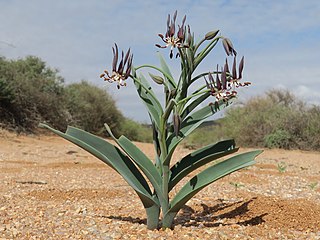
Ornithoglossum vulgare is a lily characterized by blueish to grey-green, boat-shaped leaves, which clasp the stem and an attractive flower arrangement. The plant usually grows to about 30cm high, but can grow taller if it receives more moisture.
Kedrostis africana is a species of flowering plant in the family Cucurbitaceae. It is native to Namibia and South Africa. It has gained the Royal Horticultural Society's Award of Garden Merit as an ornamental.
Oxalis inaequalis is a bulb-forming species of flowering plant in the wood sorrel family. It is native to South Africa's Cape Provinces. Each plant produces a rosette of up to 70 succulent leaves, which occasionally produce aerial bulbs. The flowers are yellow and copper-coloured. The sepals are of unequal sizes, hence the specific epithet "inaequalis", which is Latin for "unequal".
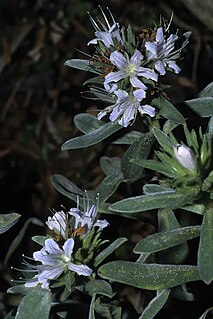
Lobostemon montanus, the turquoise bush bugloss, mountain lobostemon or agtdaegeneesbos, is a South African species belonging to the forget-me-not family.

Lobostemon belliformis, the Gouriqua lobostemon or beaut healthbush, is a critically endangered species in the forget-me-not family. It is known from a single locality on the Riversdale Plain in South Africa.
Lobostemon collinus, the pyjamabush or iron healthbush, is a species belonging to the forget me not family. It is known only from the fynbos biome of the Western Cape of South Africa.














